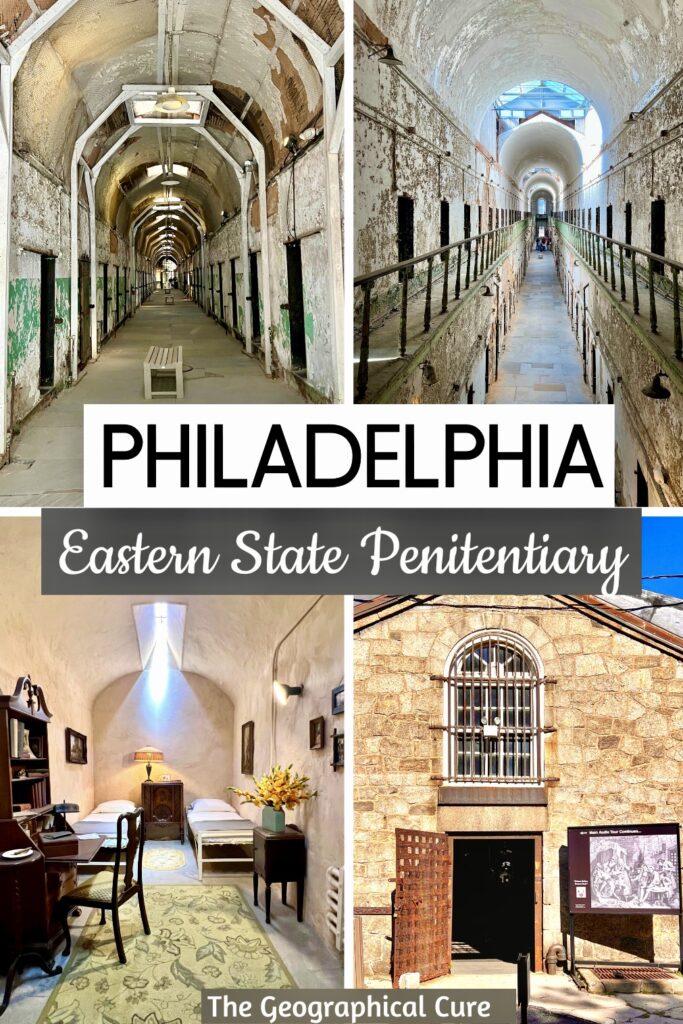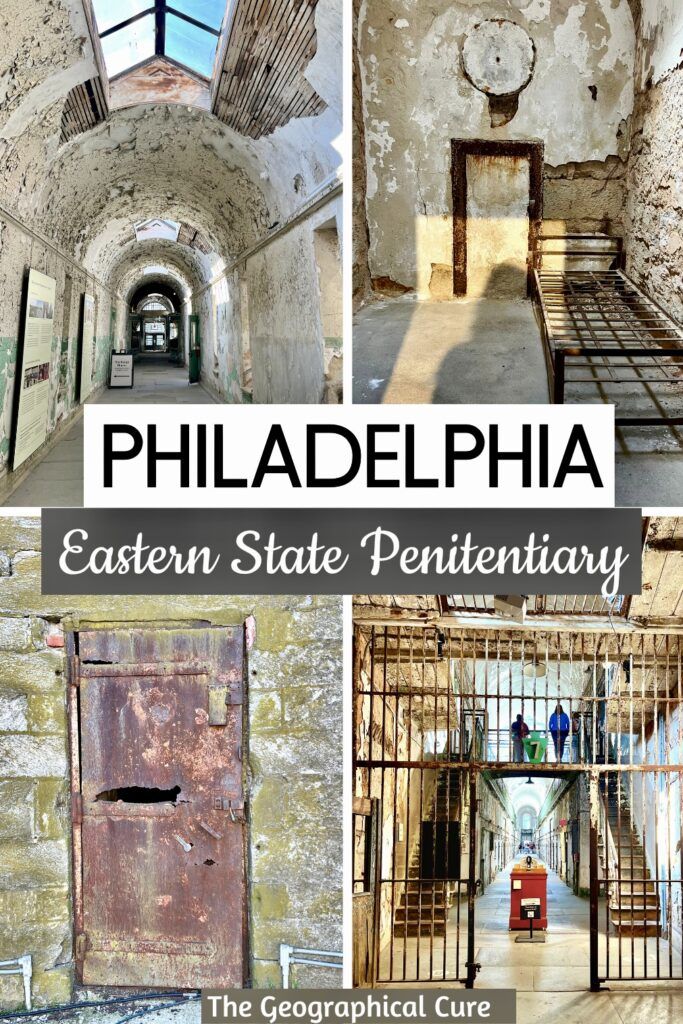Established in 1829, Eastern State Penitentiary (“ESP”) was a pioneering correctional facility with a mission to cultivate genuine remorse, or penitence, in its prisoners. Its innovative approach to solitary confinement set the stage for worldwide prison reform.
On the outside, ESP had an imposing Neo-Gothic exterior with 30 foot walls, turrets, and gargoyles. Inside, it resembled a monastery, with high vaulted ceilings and cells with “eye of God” skylights.
Following Enlightenment ideas, prisoners were kept in isolation, away from others. This tactic was meant to encourage reflection on their misdeeds and instill a desire to repent and reform.
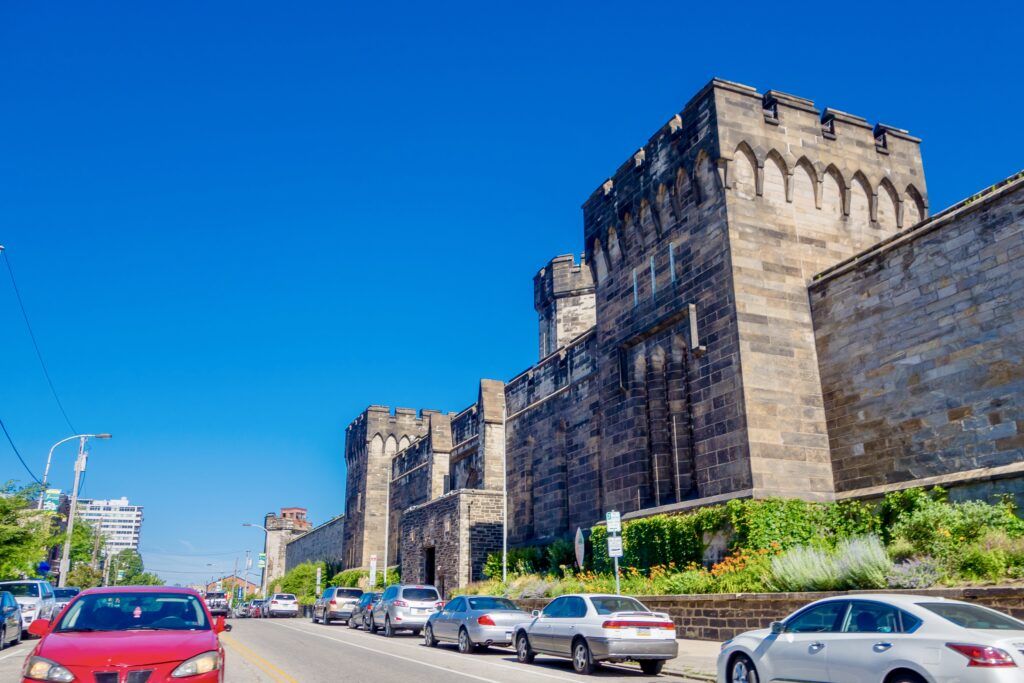
While the intent of the Quaker prison reformers was honorable, their theory of remediation was flawed. Isolation didn’t miraculously cure the prisoners. (No surprise!)
Rather, as Charles Dickens had foretold, the extreme isolation was “cruel, wrong, and tampered with the mysteries of the brain.”
Many of the prisoners were never remediated and became recidivists. On top of that, ESP became overcrowded, disease ridden, and its infrastructure broke down. As a result, the collapsing prison was closed for good in 1971.
In this Eastern State Penitentiary guide, I give you a history of the now ruined prison and tell you everything to see on a visit.
>>> Click here to book a ticket to ESP
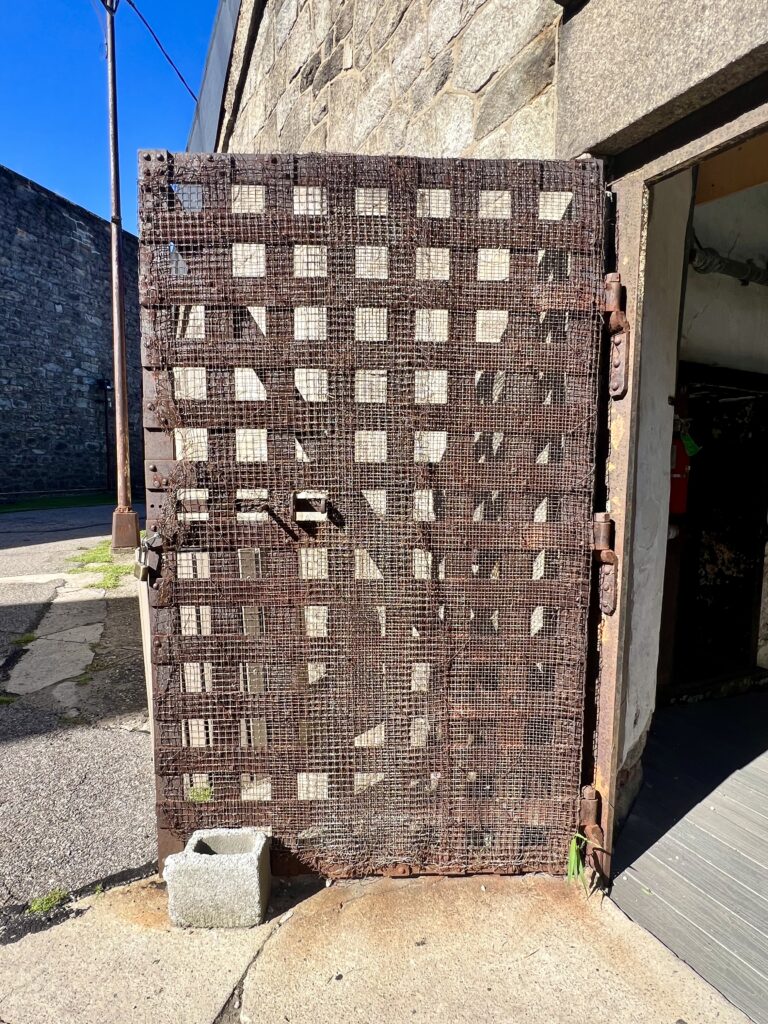
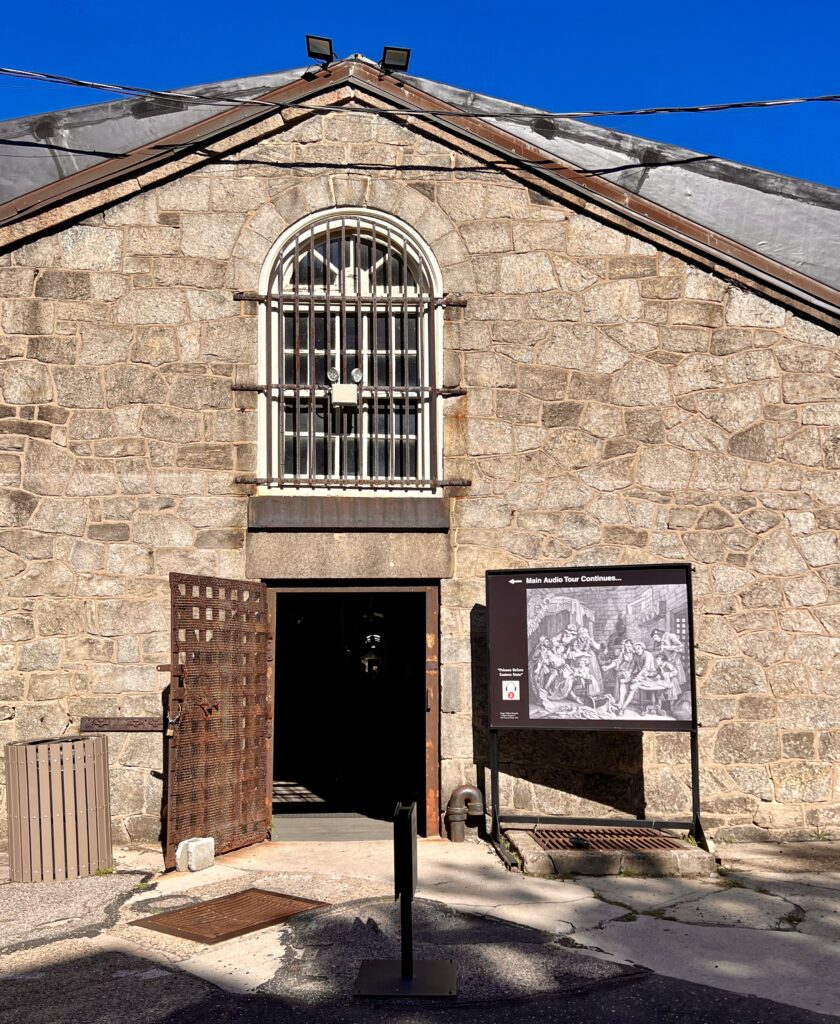
History of Eastern State Penitentiary
Philosophy
ESP opened on October 25, 1829 and operated until 1971. The penitentiary was designed by architect John Haviland based on the principles of the “Pennsylvania System,” a pioneering approach to prison reform.
The system was the brainchild of civic-minded Quakers who wanted to alleviate the miseries of mass incarceration in public prisons. The would be reformers included Benjamin Rush and Benjamin Franklin.
The prison was designed with these reformist principles in mind. The goal was to provide a humane and rehabilitative environment that would allow inmates to reflect on their crimes and improve morally and spiritually.
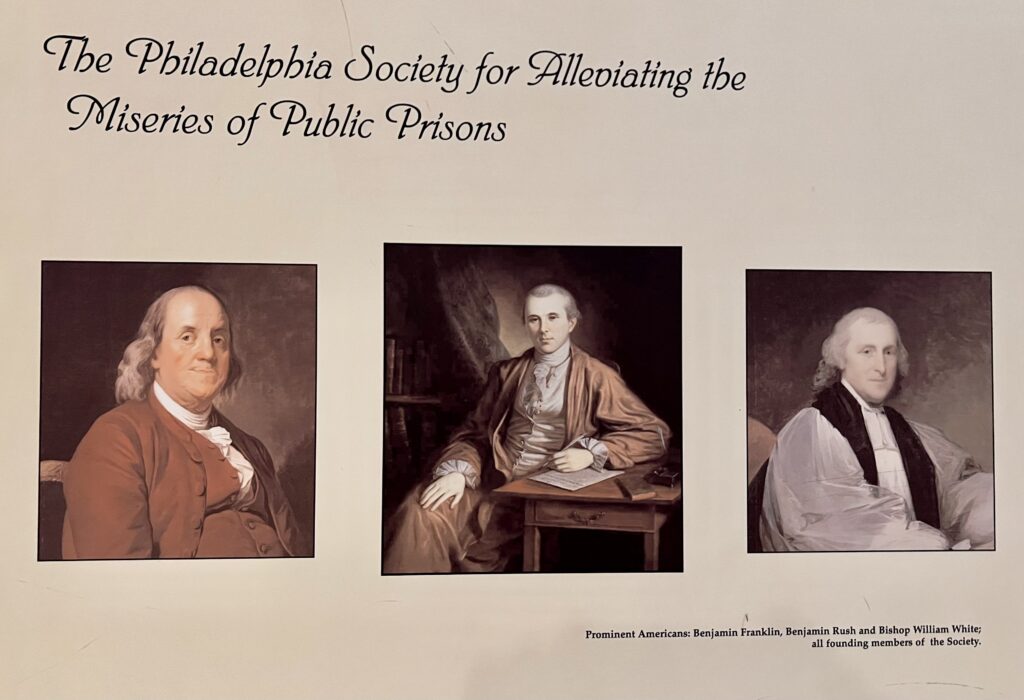
Key to this mission was the principle of solitary confinement.
Previously, prisons were just detention pens where criminals, murderers, thieves, and even children were all thrown together with little to sustain them. They often died from violence, cold, or starvation.
The antidote to mass incarceration, the reformers thought, was the other extreme — isolation and confinement in more humane conditions that would deter violence.
If crime was a “moral disease,” it could cured in a church-like environment where the prisoners could experience spiritual remorse.
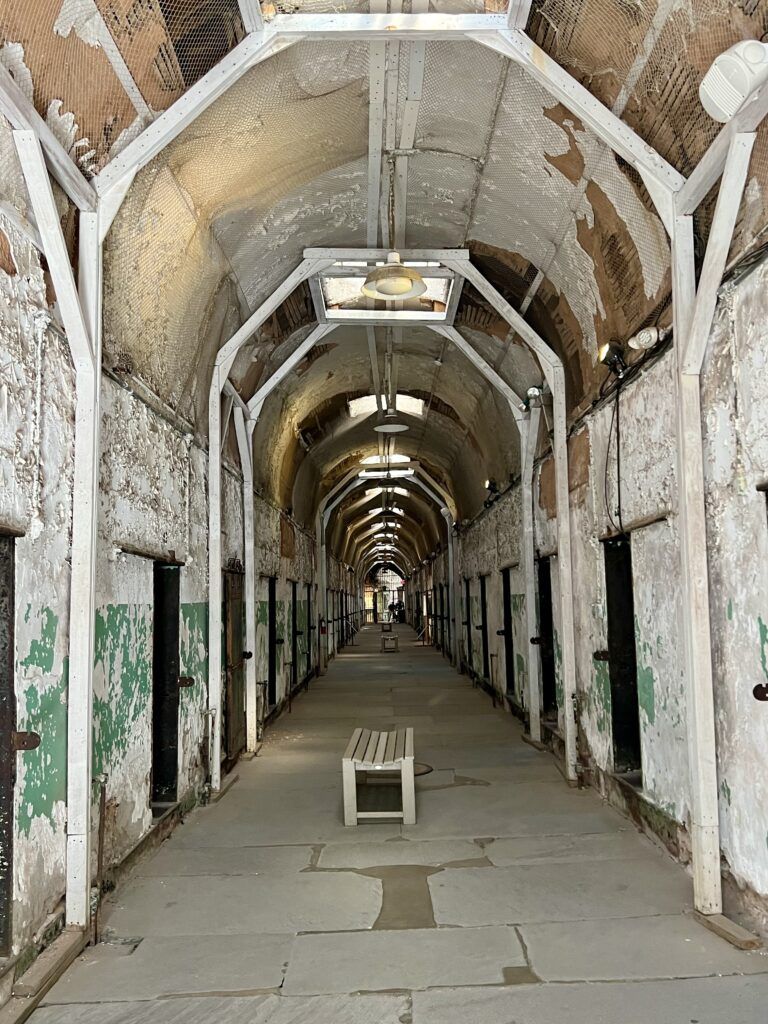
Design
The prison they envisioned, and which opened in 1829, was unlike anything that had been designed before.
Seven wings of cell blocks radiated from a central hub. This gave guards stationed there a clear line of sight down the long, straight cellblocks extending from the center. And made it easier for guards to monitor inmate activity and respond quickly to any issues.
The cellblock design was copied around the world, making ESP a historically influential prison.
The interior of ESP was designed to appear like a church or a monastery. The cellblocks had tall vaulted ceilings. The cells were also vaulted, and each had a glass skylight called the “eye of God” from which light streamed in.
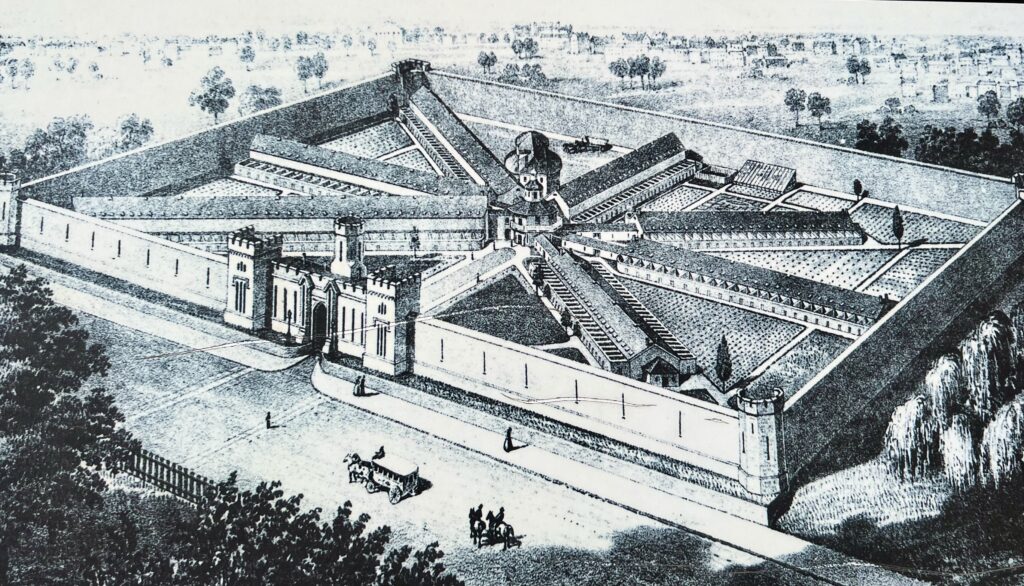
The doors to the cells were small. Prisoners had to stoop to get in, as if they were bowing to god. They were fed through a tiny “feed door.”
The prison infrastructure was a vast improvement from other prisons.
The private cells all had central heat, flushing toilets, and shower baths. Even the White House didn’t have these luxuries at the time. When completed, ESP was the most expensive building ever constructed in the US.
For 23 hours a day, prisoners ate, slept, worked, and lived in their 8 x 12 foot cells. Their only reading material was the Bible.
And they were only let outside, to a tiny courtyard through the back door of their cell, for two half hour sessions a day. Schedules were synchronized so that the prisoners couldn’t see each other or communicate.
Exposure to other humans was considered an evil. When inmates left their cells, they were hooded so they wouldn’t see anyone.
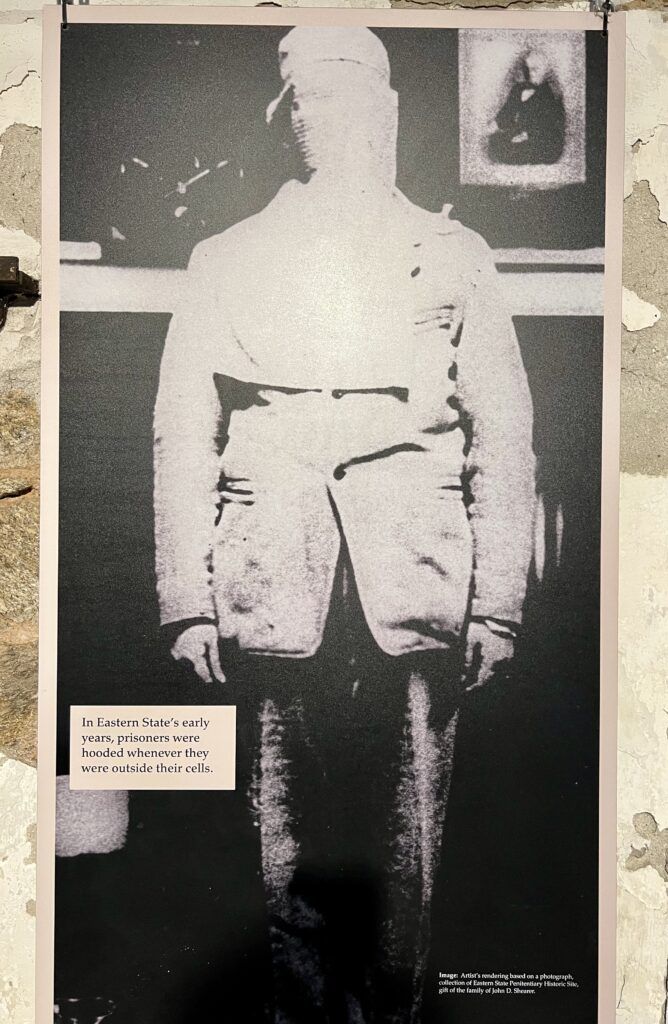
People were fascinated with this new penal system. For a time, the prison received more visitors than Independence Hall.
Europeans and philosophers from around the world came to inspect the prison. Alex de Tocqueville praised the reform system. He thought it was “severe,” but that it would promote reflection and religion.
Not everyone was convinced though. Charles Dickens was horrified by the concept. He thought isolation would “tamper with the brain” and was worse torture than beating or physical punishment.
Failure of ESP’s Prison Theory
In the end, Dickens was right. The controversial Enlightenment thinking had not been so enlightened after all.
It was, in fact, naive. In reality, solitary confirmation only worsened the mental health of most inmates.
In 1913, ESP gave up on its lofty ideal of splendid isolation, which really just broke people and was another form of punishment. Instead, the prison had inmates work, play, and share cells together.
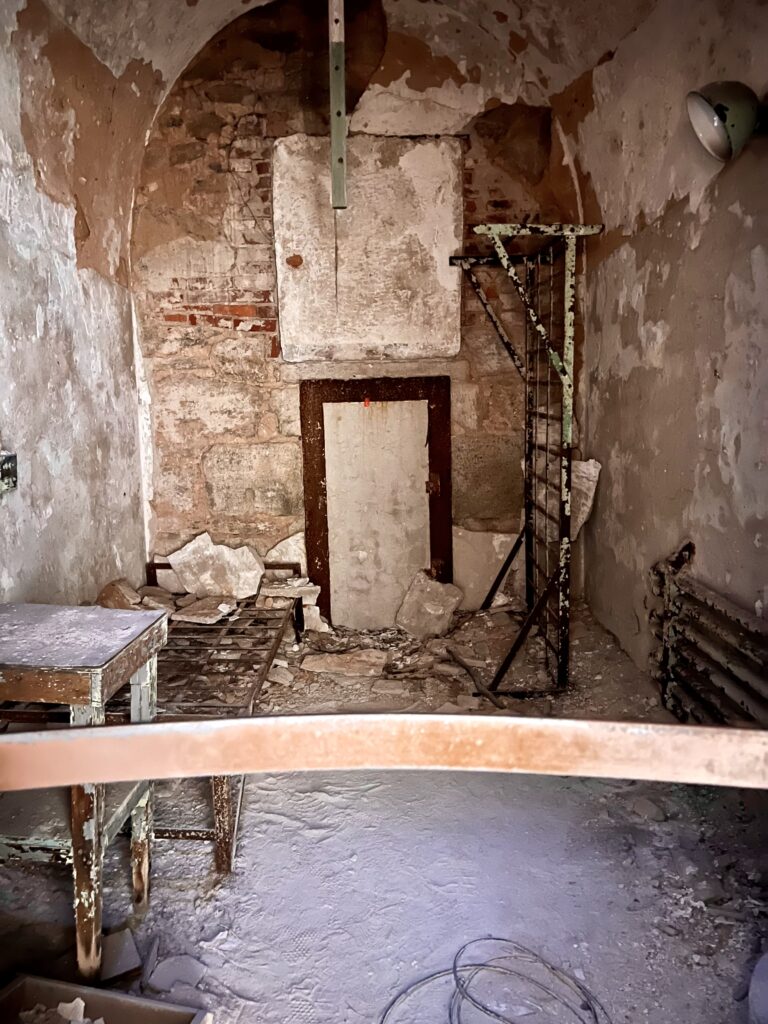
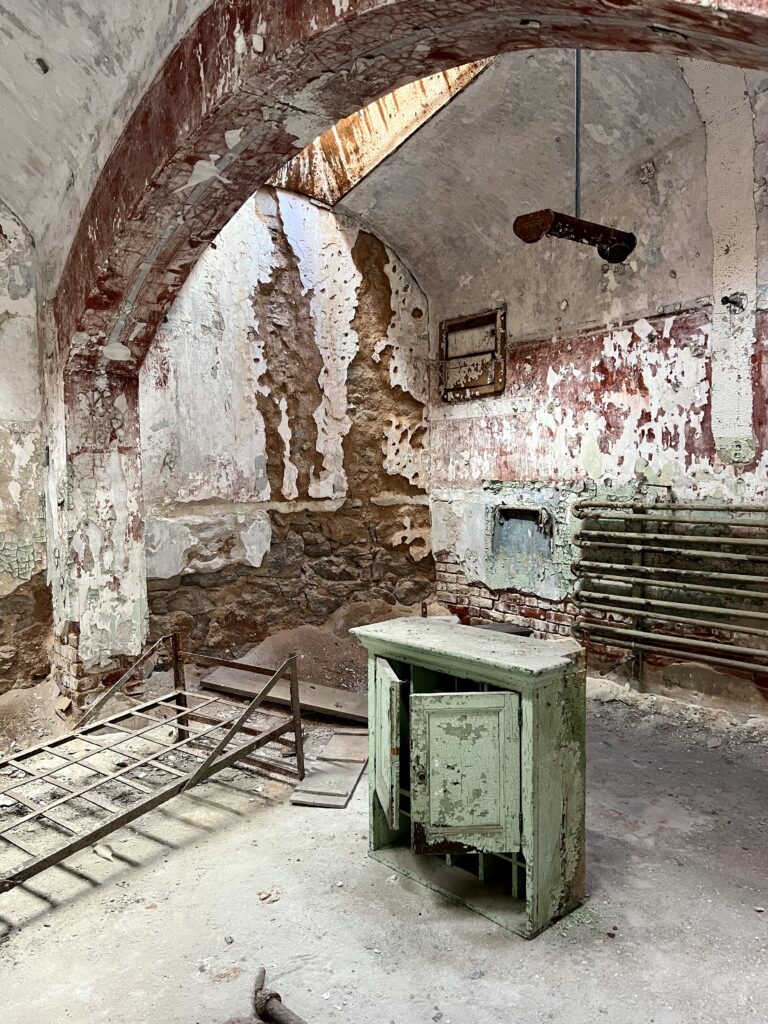
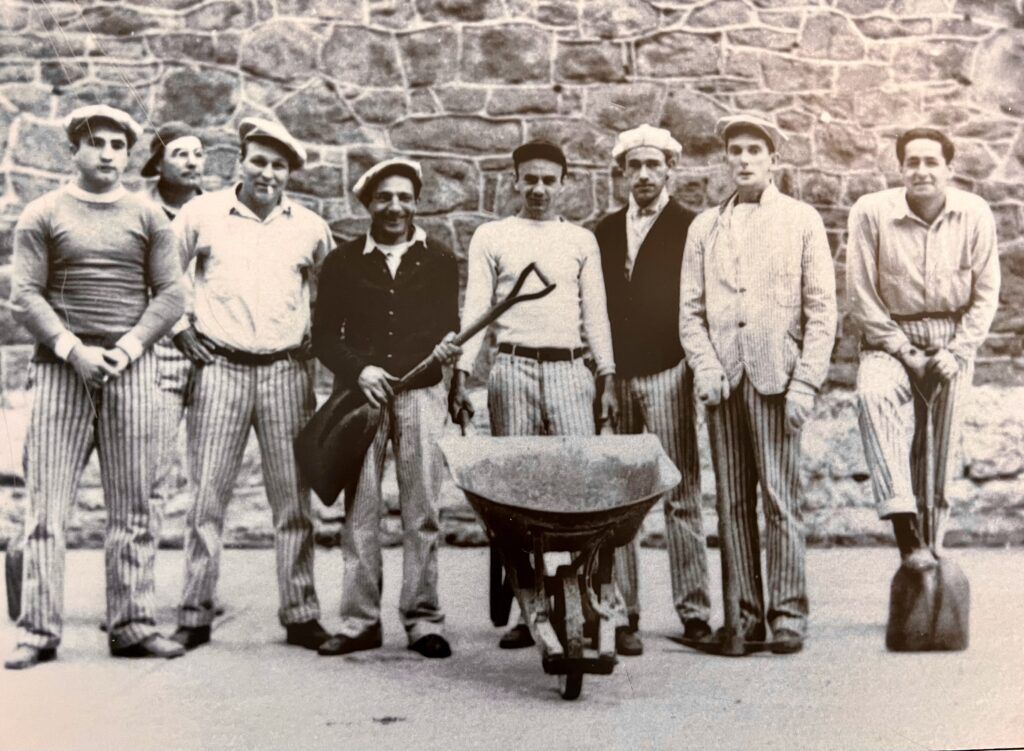
As time went on, more and more prisoners came to ESP. More cells were built, including ones below ground. Severe overcrowding eventually undermined the prison.
Over the years, ESP held 750,000 prisoners. Some never left. ESP closed in 1971.
Government officials thought about re-purposing the prison, rather inappropriately, as a shopping mall or apartment complex. But, in the end, ESP opened as a museum in 1994.
Though preserved, ESP remains in a state of stabilized semi-ruin. And the museum points out that you assume all risk of bodily harm. Though it seemed perfectly safe to me.
You’ll see peeling walls, crumbling cells blocks, and furniture askew. There is dust everywhere. It will be spooky to some. (Children under 7 are not allowed to visit.)
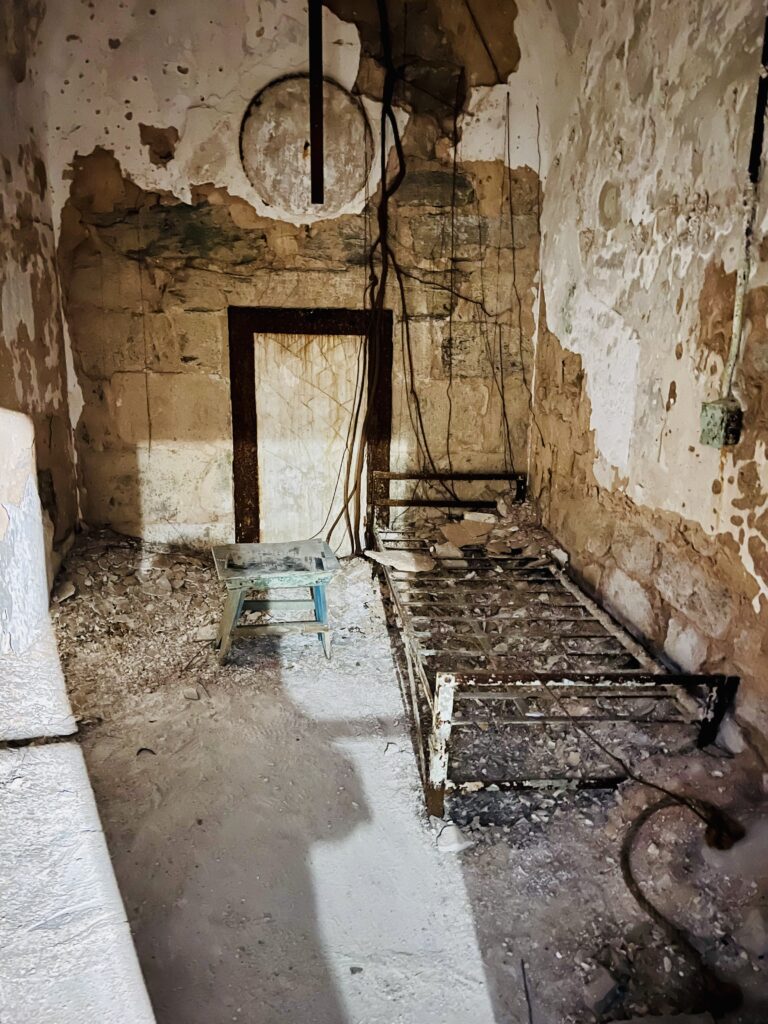
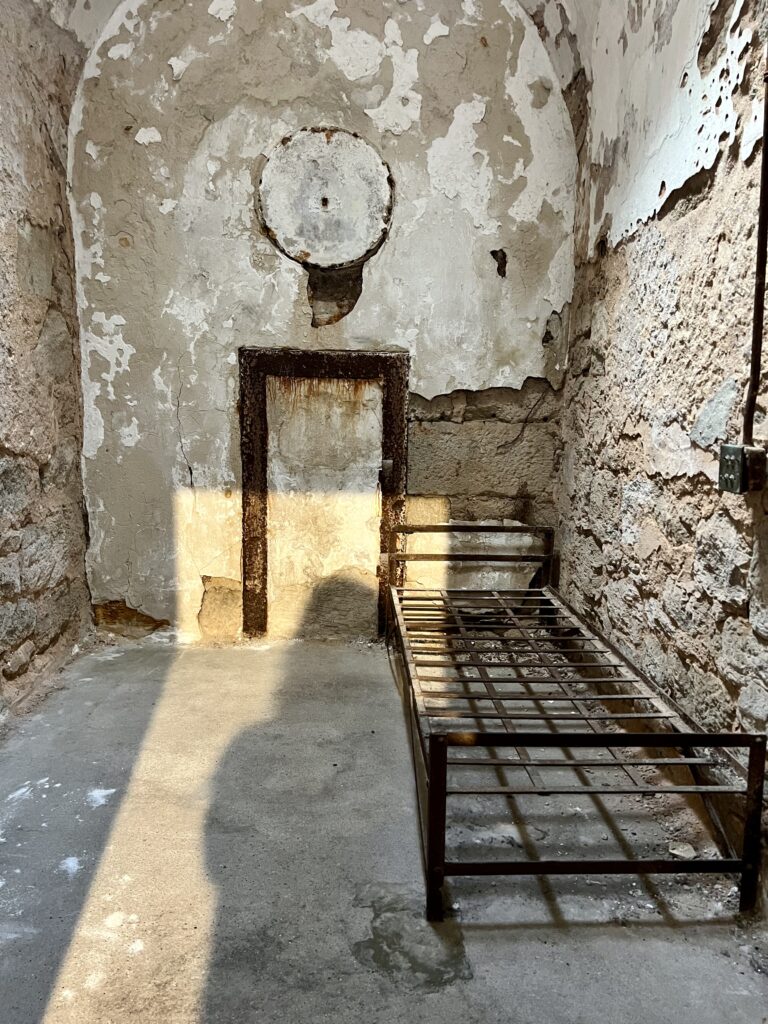
But the abandoned prison also has eerie beauty, with its unique architecture, historical significance, and the passage of time. The combination of aged stone and a storied past creates a haunting atmosphere that’s akin to “ruin porn.”
Guide To Eastern State Penitentiary: What To See
Here are the highlights and best things to see on a visit to ESP.
Overview
The audio tour begins just outside the Visitor Center. You can see the prisoner’s exercise yard. Once inside, you’ll be in cellblock 1.
There are a total of 15 cellblocks within the penitentiary, each with its own unique features and history. These cellblocks contain hundreds of individual cells.
Visitors can explore the prison’s various wings, yards, and outdoor spaces. In addition to the cellblocks, ESP has several central areas like the rotunda, the synagogue, the hospital block, and the administrative offices.
There are also exhibits and plenty of information signage.
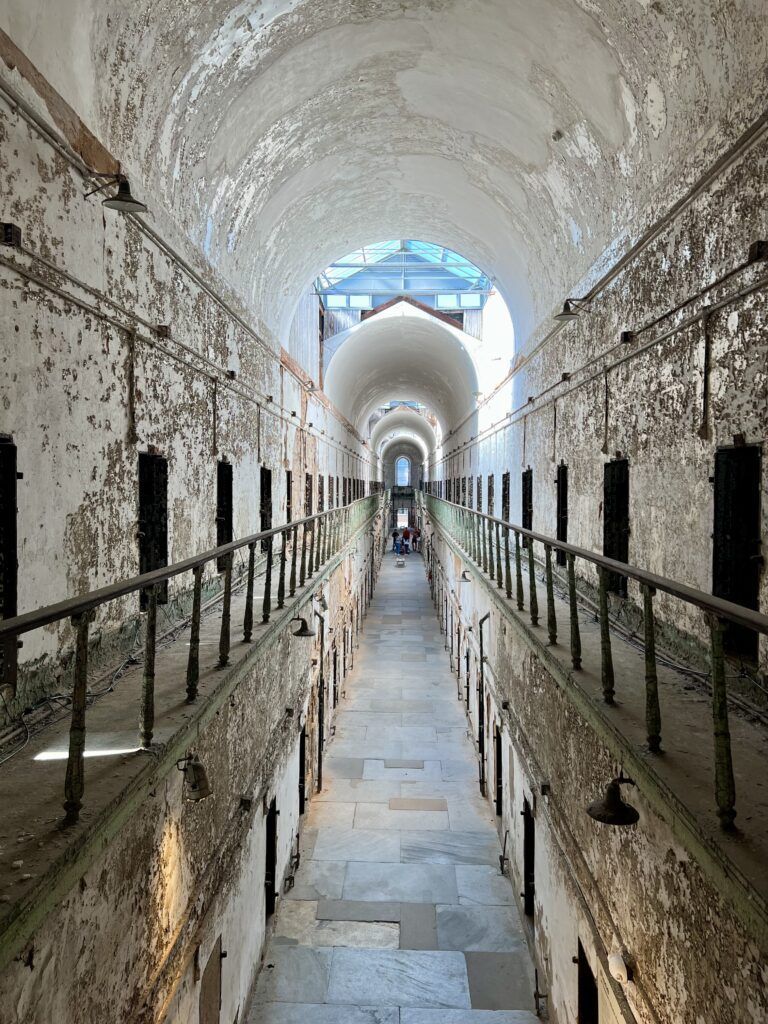
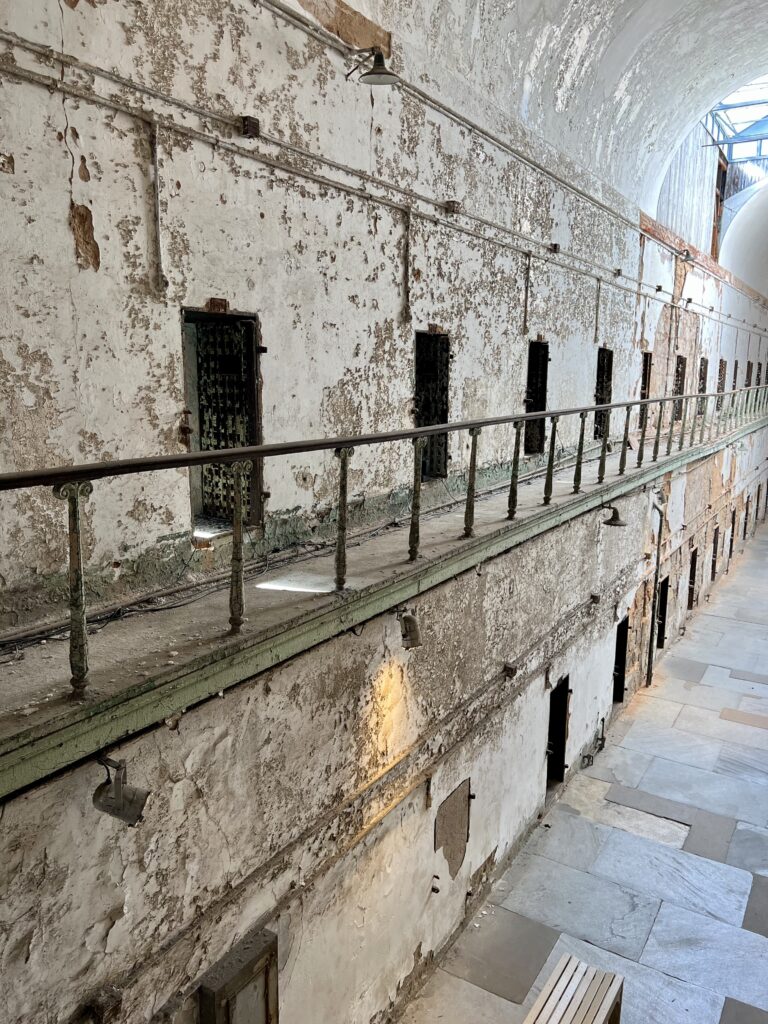
Cellblocks
Cellblocks 1, 7, 8, 9, 10, 11, 13, and 15 are open to the public. These crumbling cellblocks once held some of the most notorious criminals in American history.
In particular, you’ll want to explore cellblock 7. It’s often referred to as the “Two-Story Block.” You can walk through the tall rusty iron gate and climb the stairs up to the second level.
There are two tiers of cells, with the upper tier overlooking the lower tier. The cellblock was built in 1836 to house a growing inmate population.
The two-tiered layout allowed for increased capacity while maintaining the principles of solitary confinement. Each cell in cellblock 7 had a small exercise yard attached to it, providing some outdoor space for the inmates.
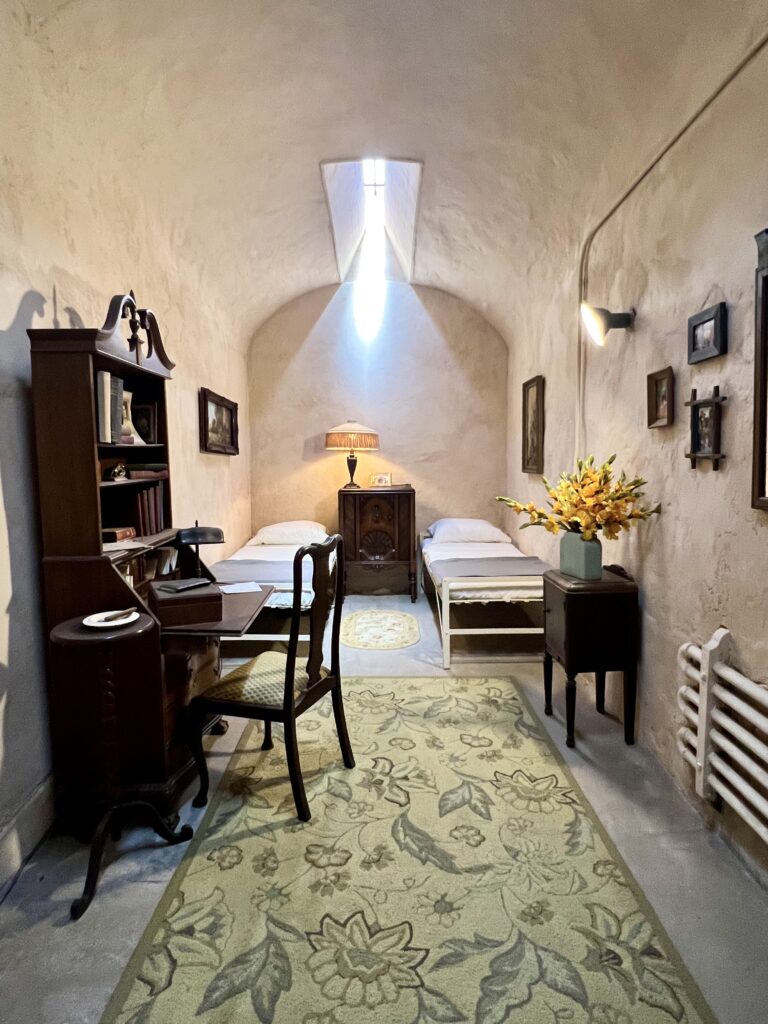
Al Capone’s Cell: Cellblock 8
ESP’s most famous prisoner was the infamous gangster, Al Capone, nicknamed “Scarface.” He was arrested outside a movie theater for carrying a concealed unlicensed revolver.
Capone was hit with the maximum sentence, one year in prison. It was his first stint in the slammer. He served 8 months, getting out a bit early for good behavior.
Capone’s reconstructed cell is just off the central hub near cellblock 8.
ESP doesn’t know exactly what cell Capone was really held in. At first, it was thought that he was housed in a luxury cell on “Park Avenue” with a radio playing waltzes.
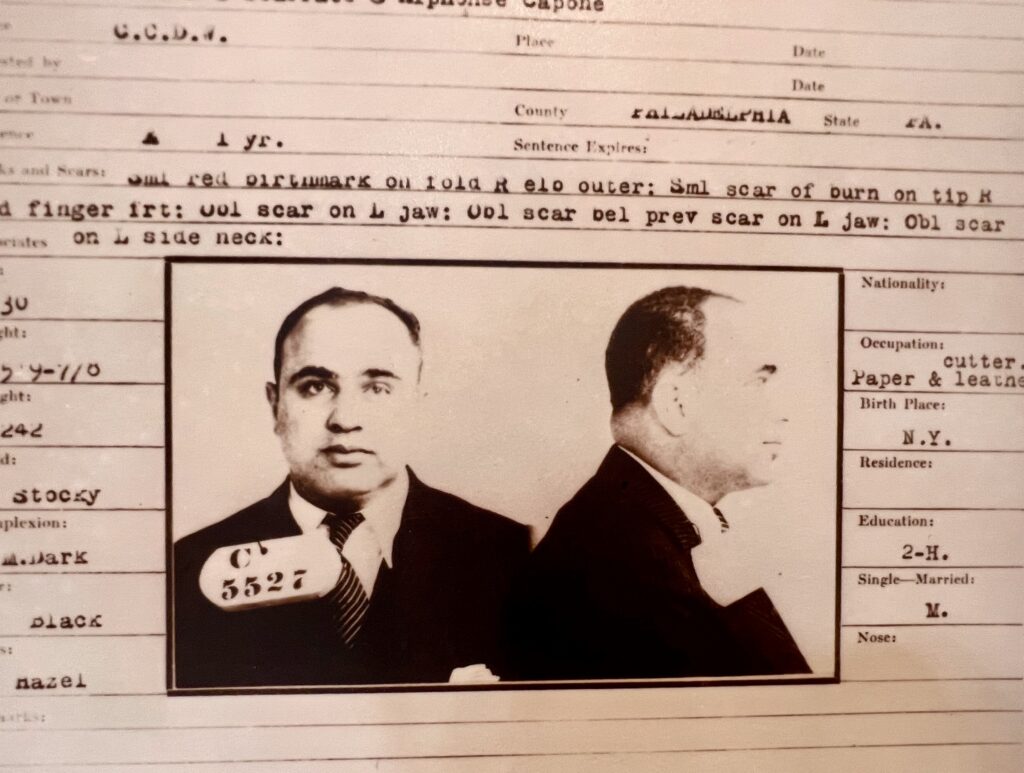
But an article in the Philadelphia Recorder in 1029 suggested a more humble cell. Capone most likely even had a roommate. Still, it had a plush decor with a desk, lamps, chair, and paintings on the walls.
The photos above show a past recreation of the supposed luxury cell (left, cell 1) and a new reconstruction of what was more likely Capone’s actual cell (right, cell 3).
The redesign featured less ostentatious period furniture, an added cot for Capone’s roommate, and a prison made rug. The walls are patched up and washed in limestone. This setting was, apparently, not much different than the other ESP prisoners.
The cell to the right of Capone’s is an interesting one. It has traces of paint that were once artistic frescos on the walls.
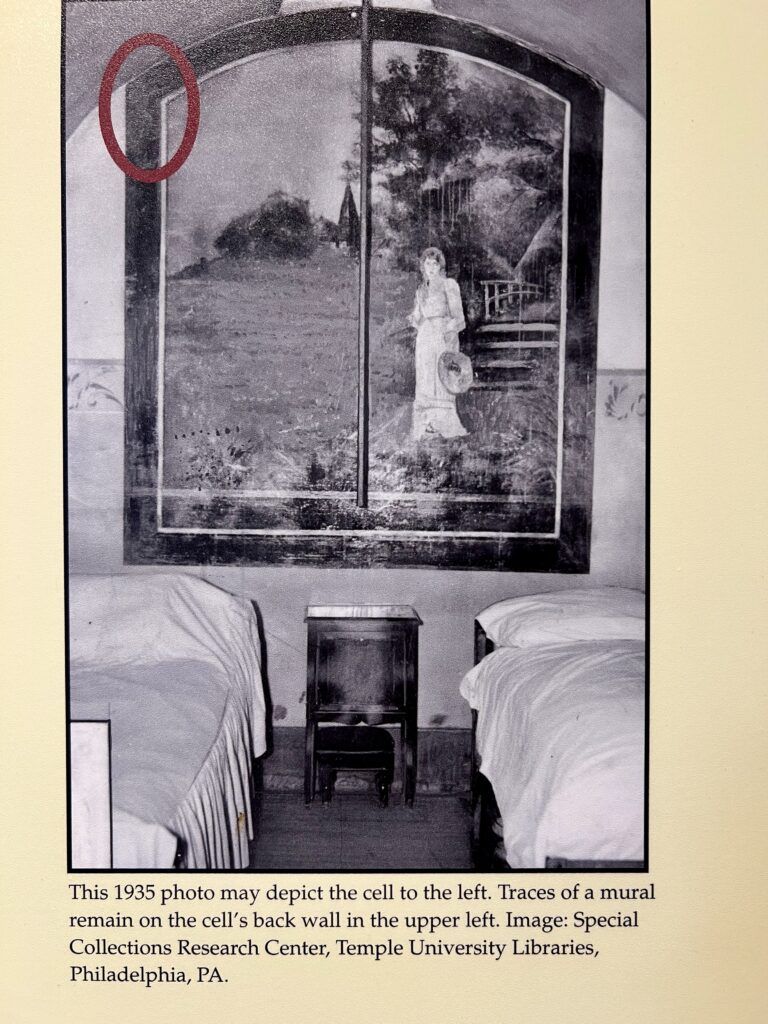
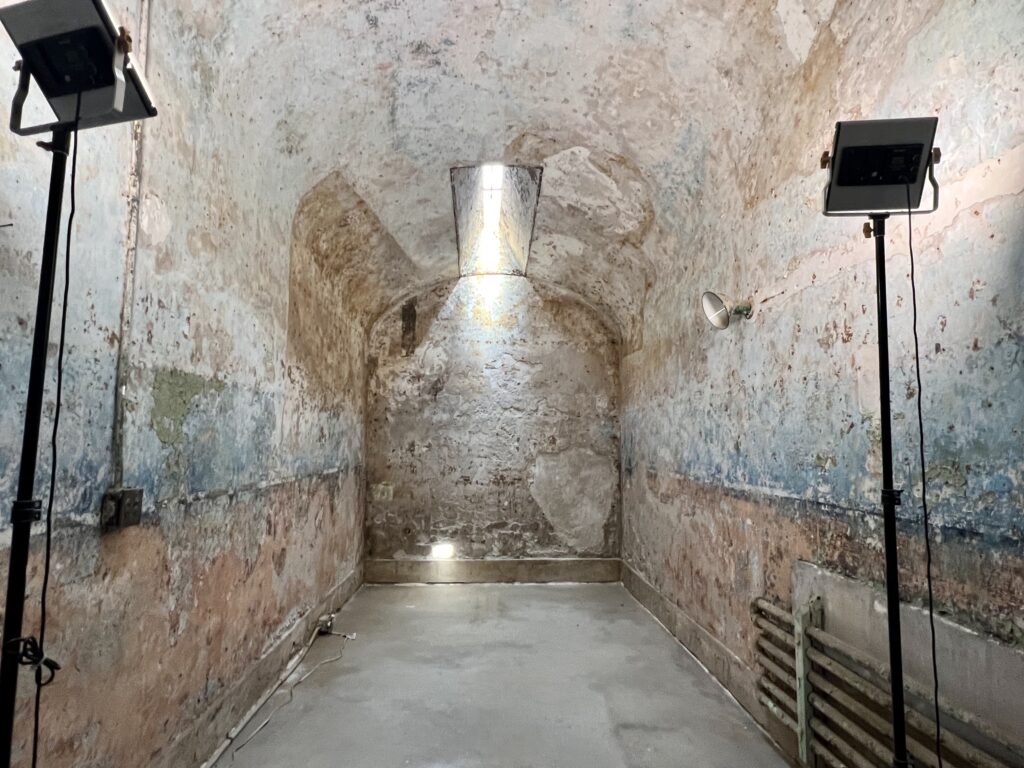
Other Famous Prisoners
Capone wasn’t the only mobster at ESP. He was just the most famous.
Other notorious lawbreakers included Slick Willie Sutton, Victor “Babe” Andreoli, Ralph “Whitey” Tropiano, and Morris “The Rabbi” Bolber.
Some prisoners had organized crime connections when they arrived at ESP. Others formed new criminal organizations while there.
“The Four Horseman” were a powerful ESP clique in the 1920s. They ran an alcohol, drug, and prostitution ring at ESP. In fact, they nearly took over control of the prison.
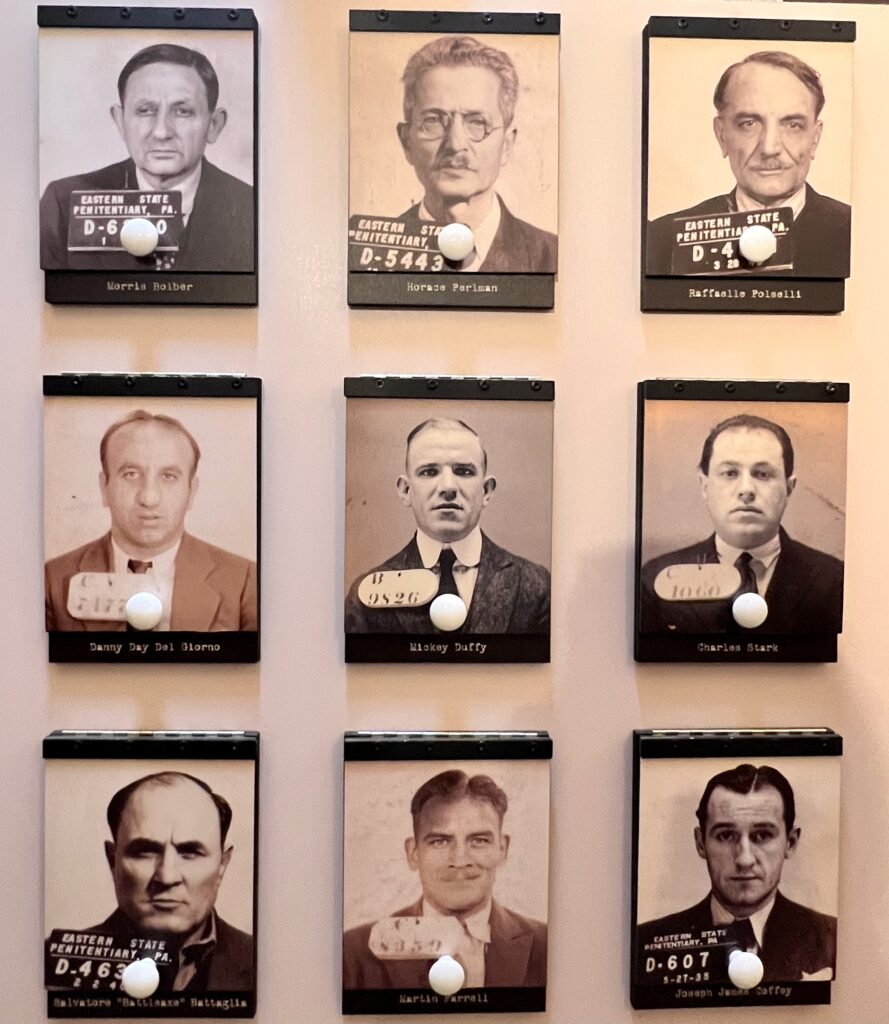
They had been appointed by a well-meaning warden to represent the entire prison population and handle small disputes. He hoped, in misguided fashion, that the appointments would instill a sense of accountability and responsibility.
But just the opposite happened. The Four Horsemen used their power to take over everything “from mail privileges to private grudges” in what was called a “unique carnival of lawlessness.”
They even stole a guard office from which to run their seedy operation. Among other things, they operated an elaborate heroin trafficking operation.
The warden was fired and replaced. And the Four Horsemen eventually squelched.
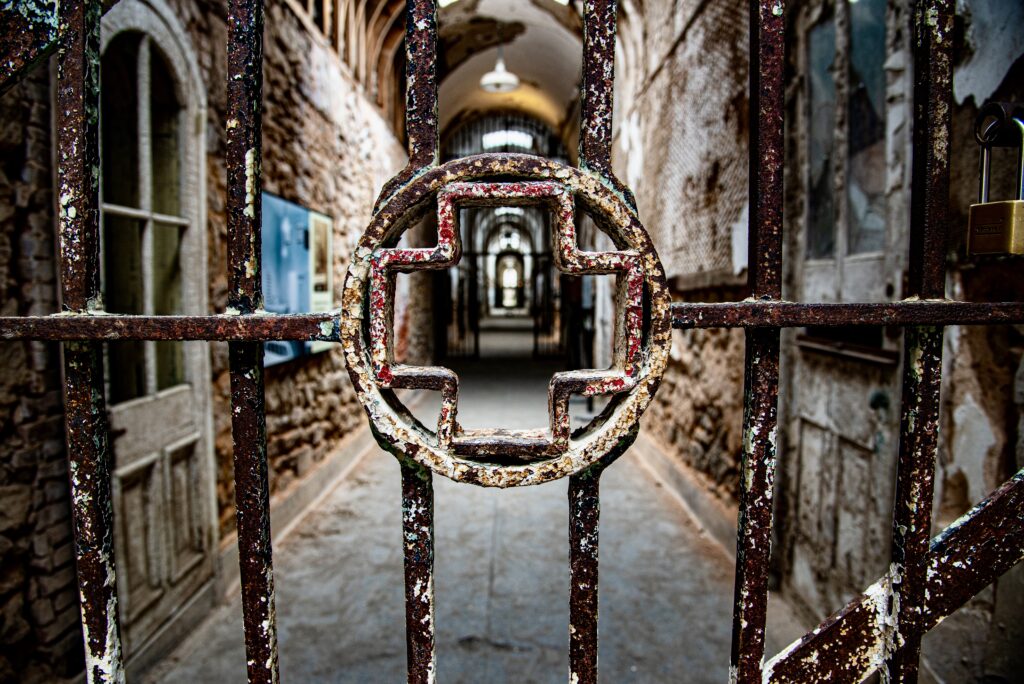
Hospital Wing: Cellblock 3
In cellblock 3, you can tour the remnants of the prison’s Hospital Block, where inmates received treatment.
Once lost to time from dilapidation, it was stabilized and re-opened in 2017. The gate has an iconic Red Cross.
The wing was entirely dedicated to health care, and was unusually well-equipped. It had an operating room, lab, pharmacy, hydrotherapy rooms, and recovery ward.
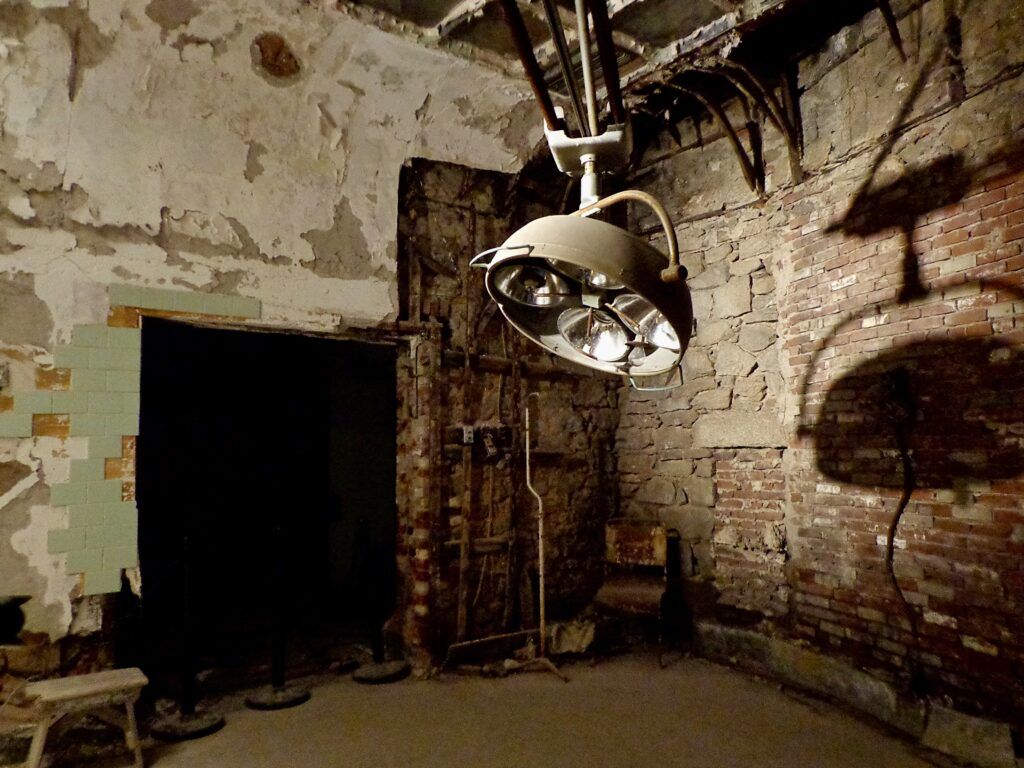
On the second floor, there was treatment rooms for mental health issues and tuberculosis. Nearly 50% of the prison inmates died from the disease.
Al Capone twice visited the Hospital Block, once for a tonsillectomy and another time for treatment for syphilis.
You’ll see rusty doctors chairs and patient beds, medical artifacts and equipment, and bedpans.
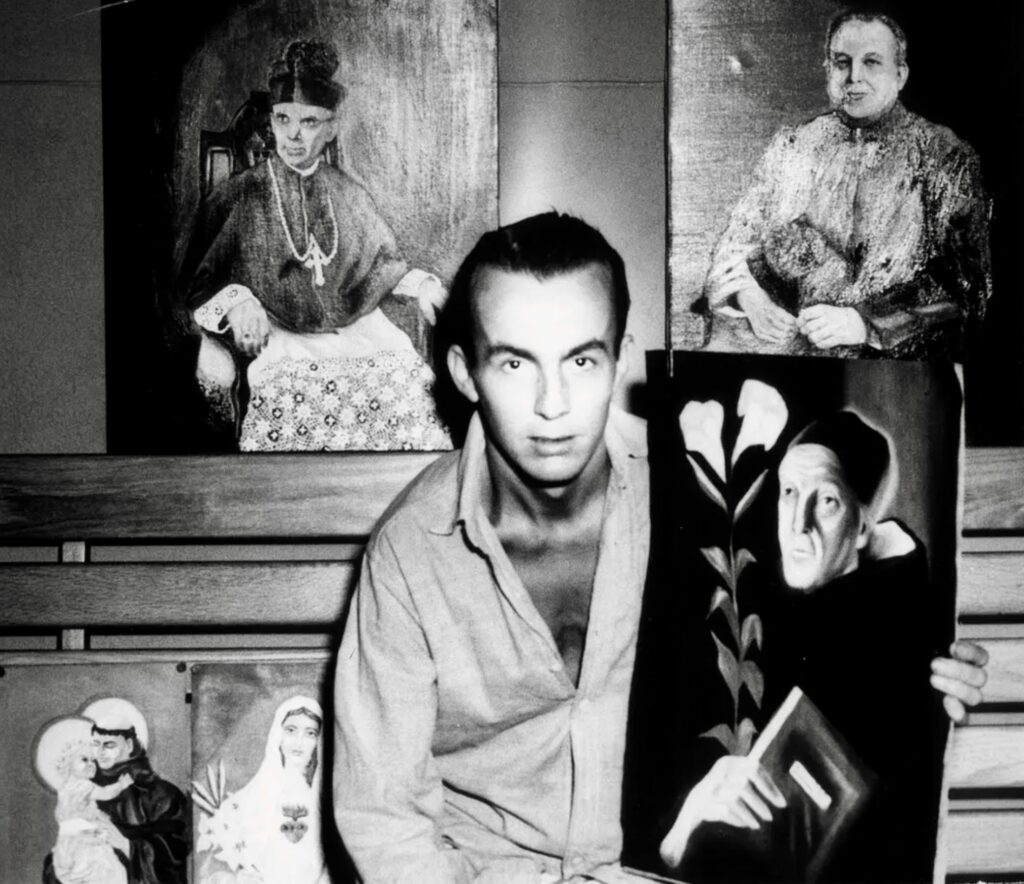
Catholic Chaplain’s Office
This was where Catholic chaplains provided religious counseling to inmates.
The office is decorated with murals by Lester Smith, a self-taught artist who converted to Catholicism while serving time in 1955. He landed in ESP after a string of armed robberies. He was one of the few prisoners who was successfully rehabilitated.
At first, Smith painted saints. But the staff noticed his talent and asked him to paint the Catholic Chaplain’s Office.
Using the pseudonym “Paul Martin,” Smith painted a total of 23 murals during his incarceration, paying homage to his two favorite saints and souls in purgatory. They were discovered in 1995, became part of the public tour in 2011, and were restored in 2014.
These delicate and striking paintings transformed the Catholic chaplain’s quarters into a unique space within the prison. Of particular significance is a mural depicting a kneeling prisoner seeking absolution through confession.
The murals are still extremely fragile and crumbling.
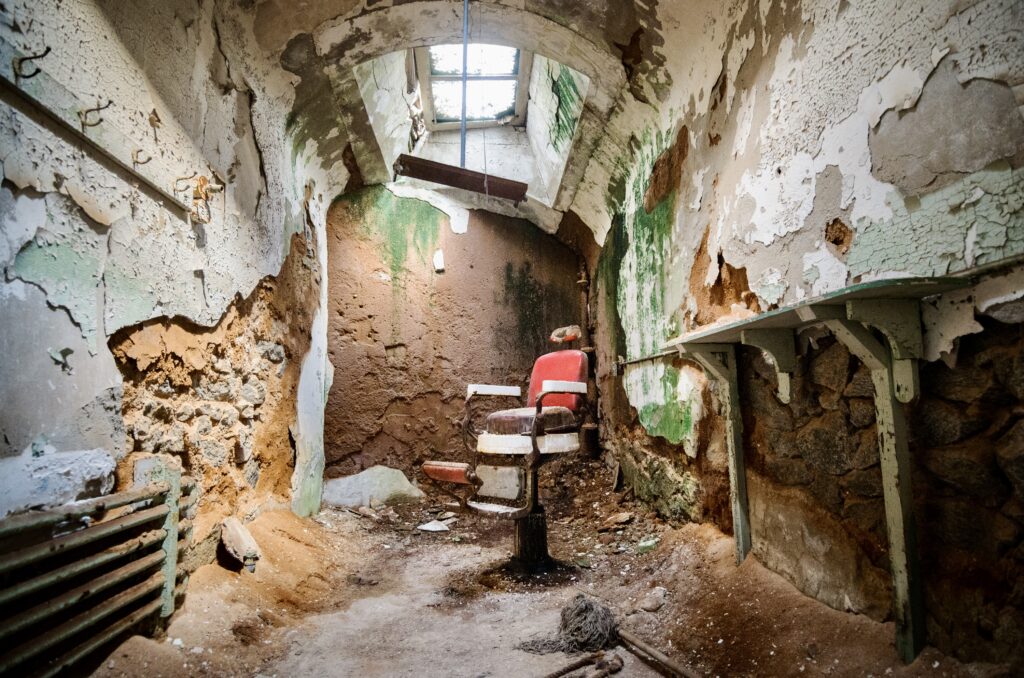
Barber’s Chair
In cellblock 9, you’ll see an abandoned barber’s chair from the early 1900s. It was a Koken classic vintage design and is displayed in a decayed cell.
This particular cellblock housed inmates, provided workshops, and had spaces for activities like barbering and shoe repair. Prisoners would get hair cuts in this cell.
The chair is sometimes referred to as the “Mad Chair.” That’s because it wasn’t just used for haircuts, but to punish uncooperative inmates. They were chained and strapped to the chair, rendered unable to move.
The punishment would literally drive some prisoners insane.
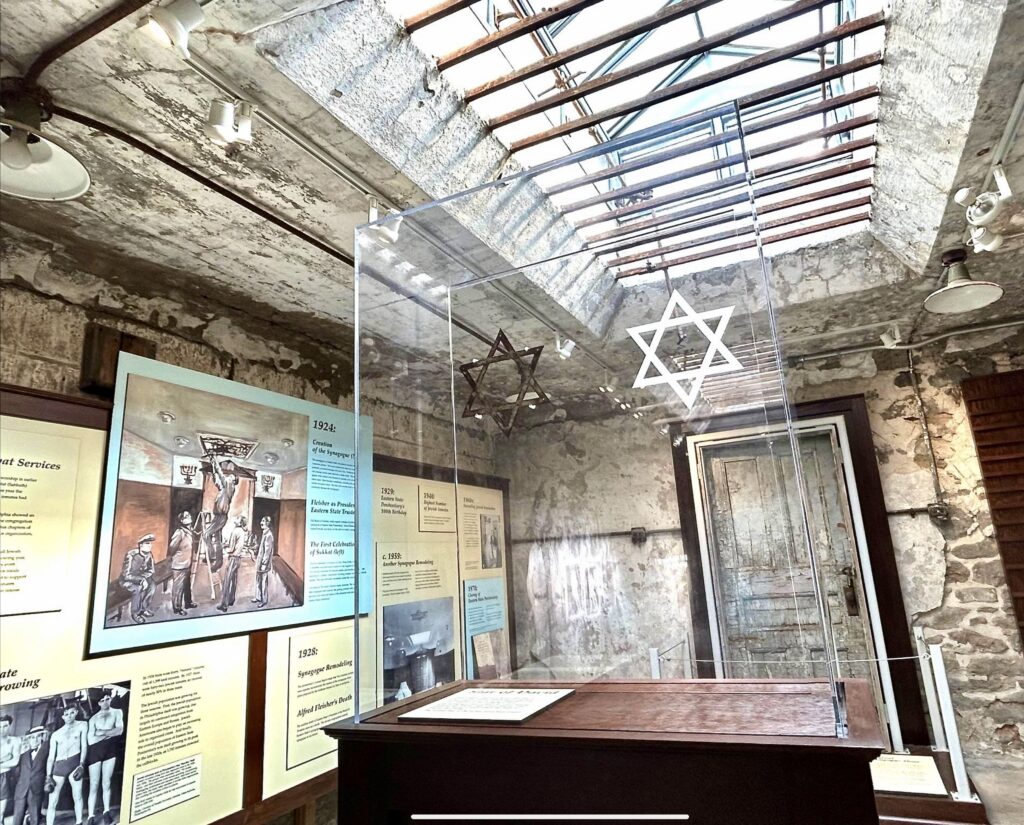
Synagogue
This was the first prison synagogue in the US. It was built in 1924 and served the Jewish inmates at the penitentiary.
It’s situated between cellblocks 7 and 8, in a space that had been four separate exercise yards.
The synagogue has been restored and reopened. There are information placards on display.
You can also see the original Star of David, which was once on the door to the synagogue.
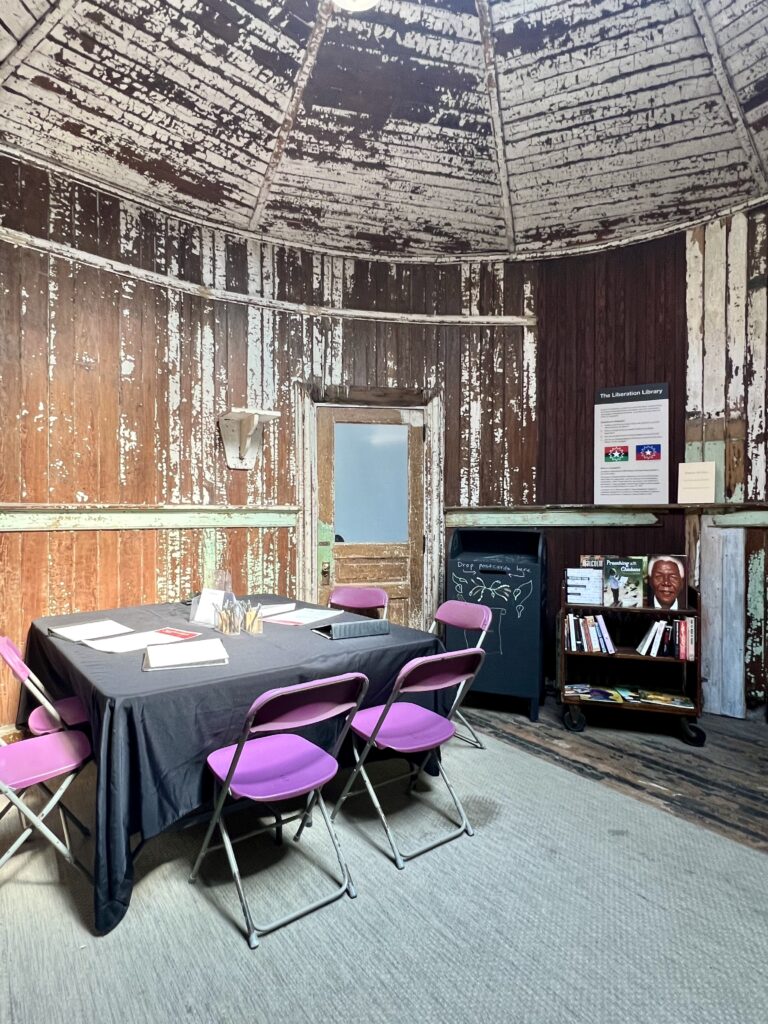
Liberation Library
The “Liberation Library” was a ESP project aimed at providing books and reading materials to inmates.
It was an initiative designed to encourage education and personal development among incarcerated individuals.
Libraries like these are now common in many correctional facilities. They serve as a resource for inmates to access reading materials, including a wide range of books, magazines, and educational materials.
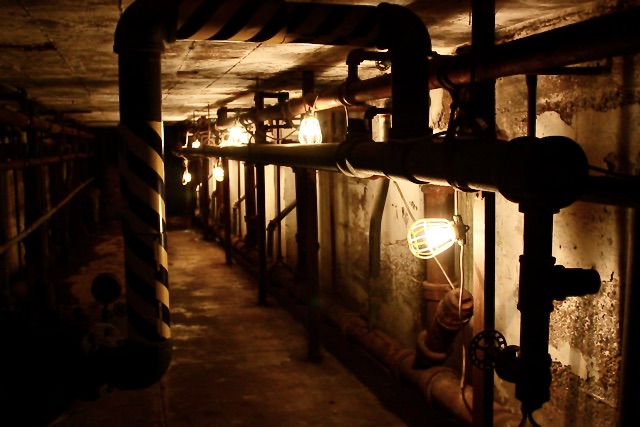
The Klondike
Down a creepy flight of stairs is The Klondike. It was a part of the prison where inmates were placed in solitary confinement as a form of punishment or for disciplinary reasons.
The windowless cells were directly below death row. Prisoners were confined here for up to 2 weeks. Horrifyingly, there was no natural or artificial light. (The lights there now are for museum visitors.)
The Klondike was known for its harsh conditions, including extreme isolation and deprivation. The prisoners had no human contact and very little water and food.
Fortunately, this practice was abandoned in the 1950s.
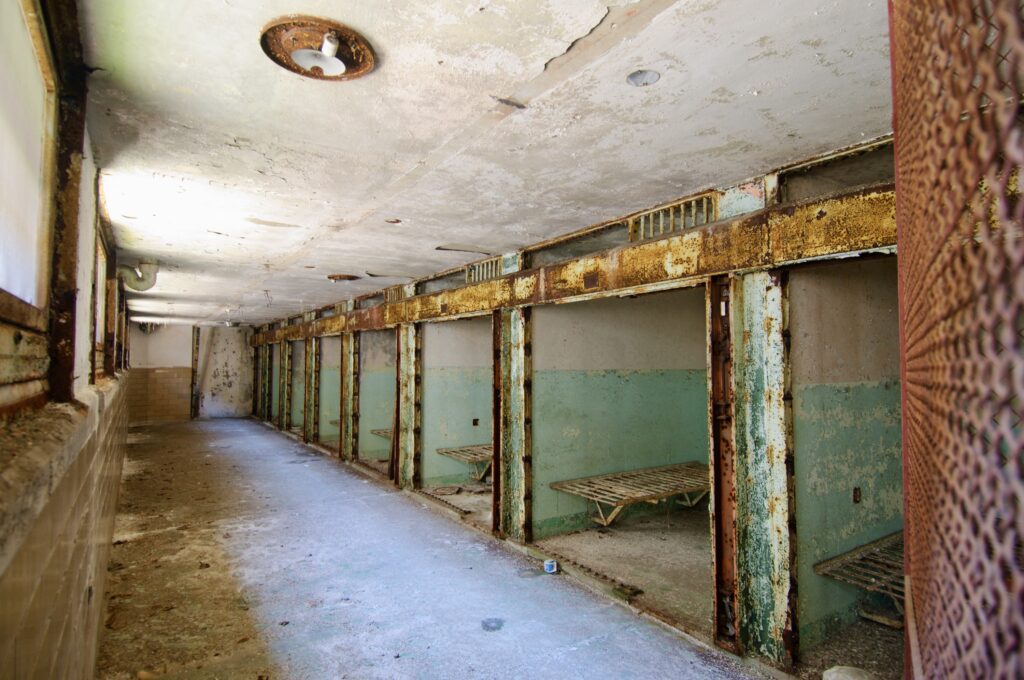
Death Row: Cellblock 15
Death row inmates sentenced to death were housed in cellblock 15. This was where the most violent prisoners ended up.
There was a panel on the wall with buttons corresponding to each of the cells. This was the only cellblock with electric doors.
This was just an inmate waiting station. No executions took place at ESP.
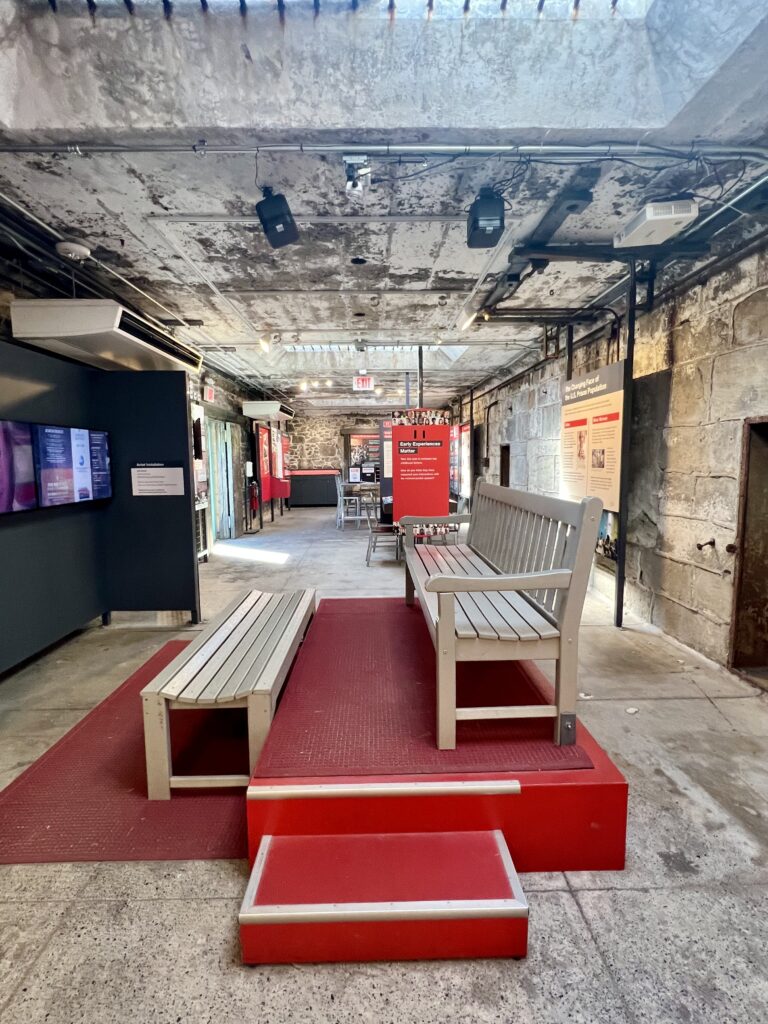
Prison’s Today Exhibit
This exhibit was installed in 2016. This is where you can learn about the history and different types of incarceration and today’s American model of punishment. The thesis is that mass incarceration isn’t really working.
The exhibit shows how your upbringing might affect your chances of going to prison. In fact, when you walk in you have to make a choice.
You walk to the left if you’ve been incarcerated or to the right if you haven’t. As I walked to the right, it informed me that I was very lucky indeed.
The exhibit features a range of multimedia installations and informational displays that address topics such as mass incarceration, the impact of the prison-industrial complex, the experiences of incarcerated individuals, and efforts at prison reform. You can listen to confessions of prisoners and visitors.
The highlight is a video installation with archival video and C-Span clips. It examines the burgeoning prison population over the decades.
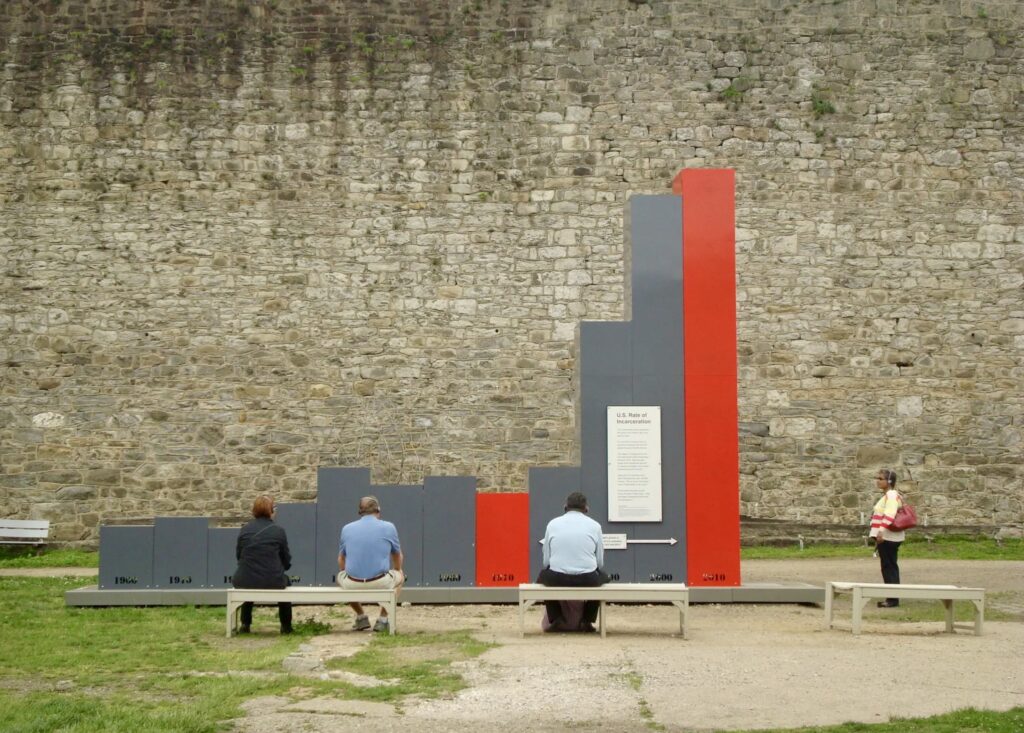
Big Graph
The audio tour ends at The Big Graph. it’s a $100,000 steel structure erected in the exercise yard.
It’s 16 feet tall and weights 3,500 pounds. The monument is essentially a 3D infographic, giving the viewer a set of statistics depending on your vantage point.
From the south, it shows the number of people in prison per a 100,000 population. Through 1980, the figure was low. But then the rate took off and there was unprecedented growth.
From the north, you can see the racial breakdown in prisons. From the east, it charts the rates of incarceration and capital punishment policies around the world.
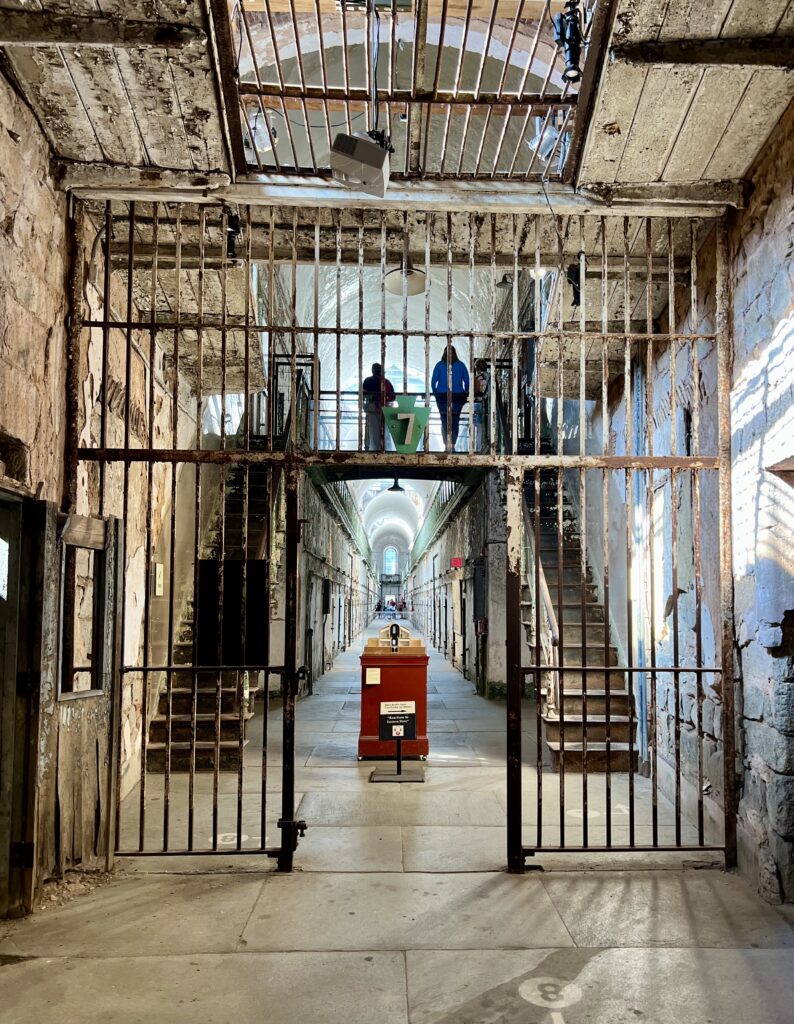
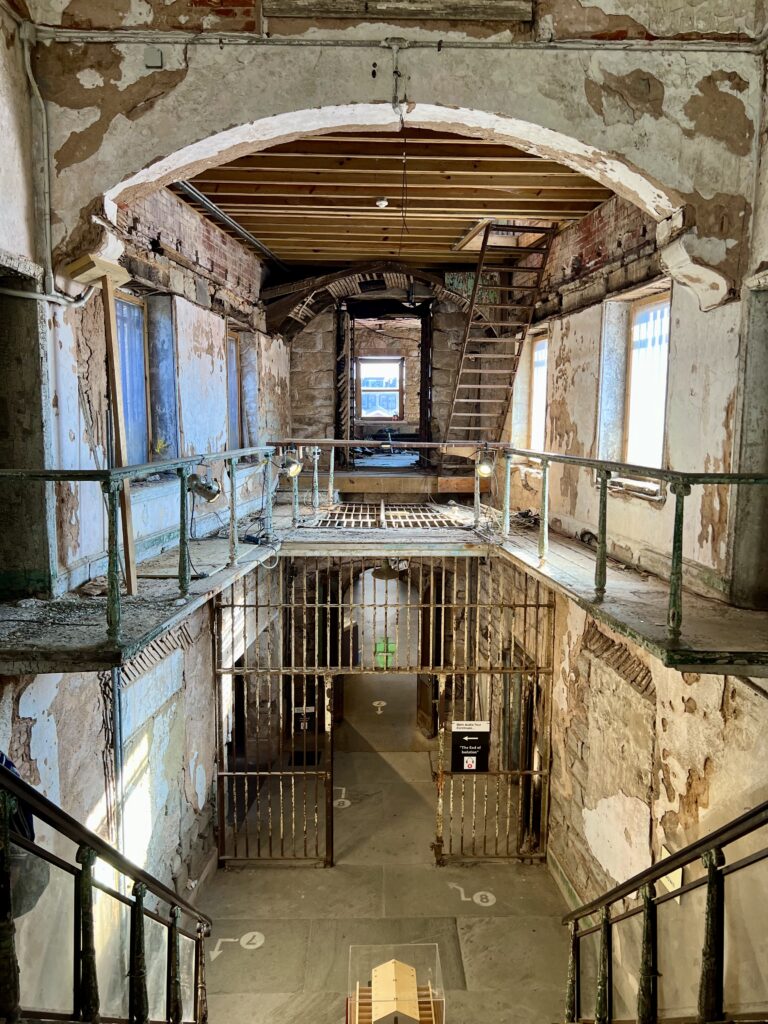
Seasonal Events
The prison is known for its haunted attraction, Halloween Nights. It takes place on selected evenings from September to November.
It’s an immersive experience with five haunted houses. There are historic tours, live entertainment, and themed bars.
I haven’t been to this event. But, with ESP’s eerie setting, I can imagine it’s as spooky as a horror movie.
Practical Guide & Tips For Visiting ESP
Here are some must know tips for visiting ESP.
Address: 2027 Fairmount Avenue, Philadelphia, PA 19130
Parking:
If you are visiting ESP on a weekday, you may be able to find free parking on the street. On a Friday in September, I was able to park right across the street.
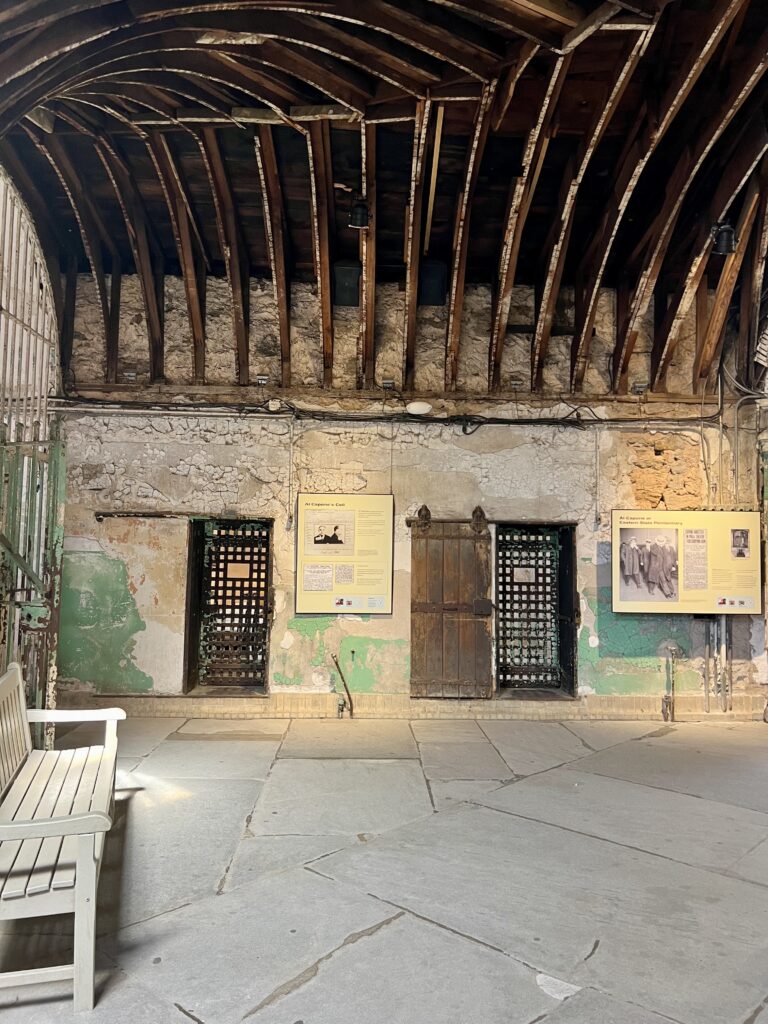
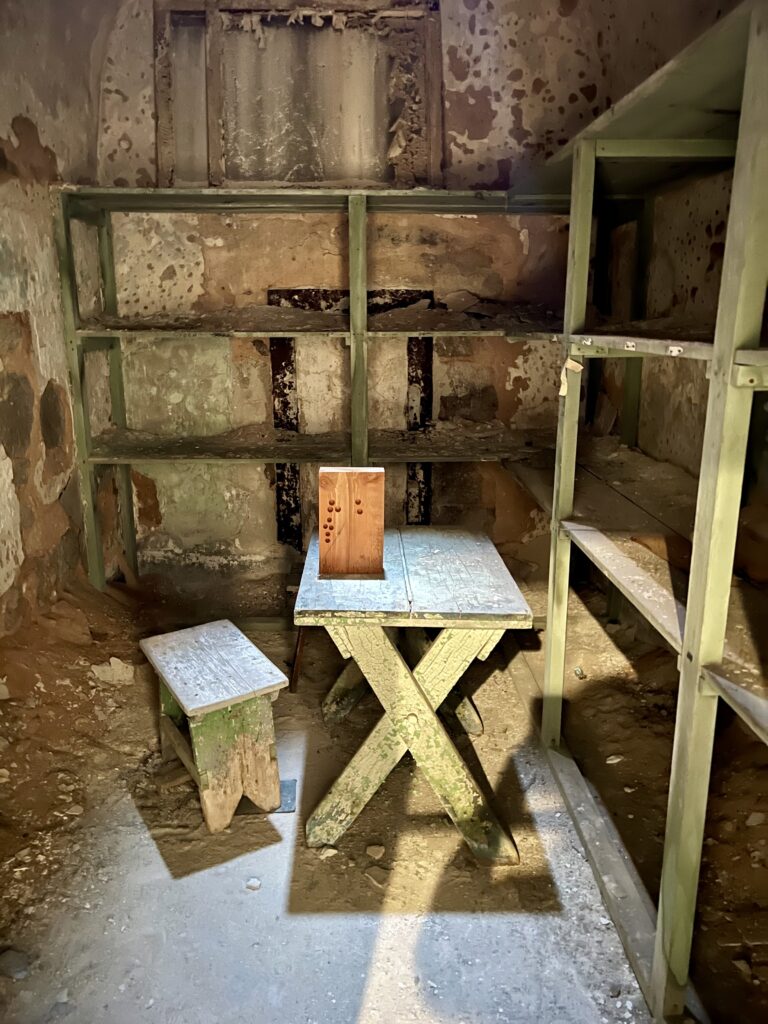
If not, there are several parking garages within walking distance of Eastern State Penitentiary, including the Parkway Corporation Garage and the Philadelphia Parking Authority Garage.
The Hop On Hop Off tourist bus stops at ESP. The prison is also close to several bus lines and is a designated stop for both the Big Bus and The Philadelphia Trolly Works.
Hours: Open daily 10:00 am to 5:00 pm
Tickets:
Self guided tours are $21. Click here to pre-book a ticket. Entry is also included in the Philadelphia Go City Pass. They will need to scan the QR code on your paper or digital pass.
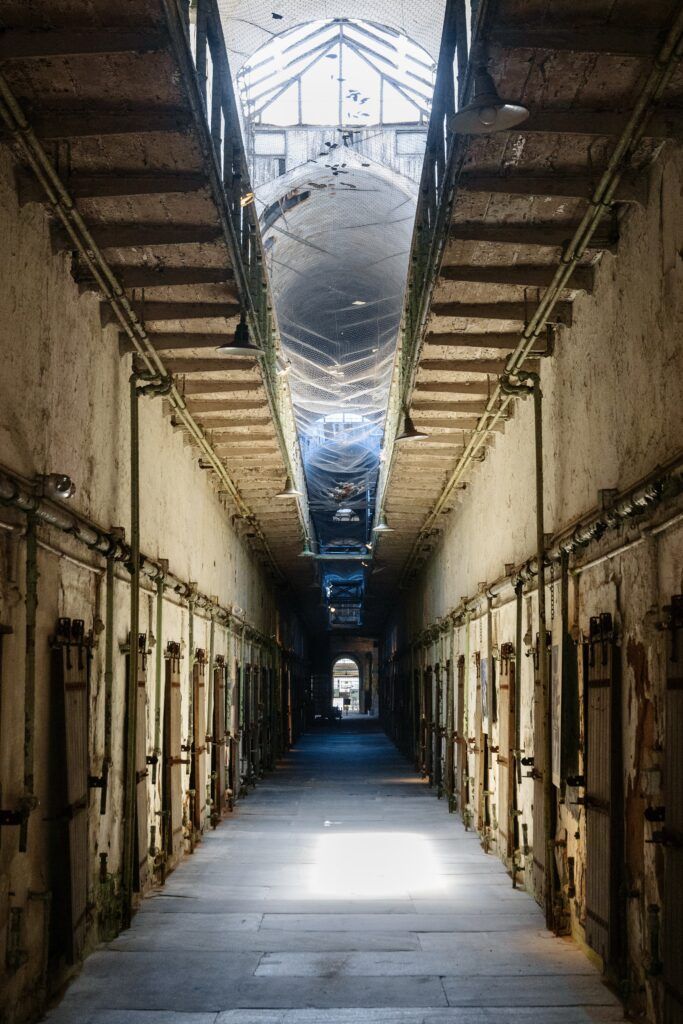
The audio guide is excellent and narrated by Steve Buscemi from the HBO show The Sopranos. It guides you around the property, giving you the history of the place along the way.
Guided Tours:
Guided tour are $21. If you are lucky, you may get a former inmate as a guide. If you take one of the tours, you will go into some cells that the general public can’t, such as the half-collapsed kitchen and communal dining hall.
The schedule for tours is:
- Every Saturday & Sunday at 10:30 am
- (Beginning March 20, 2023) Monday through Friday at 2:00 pm
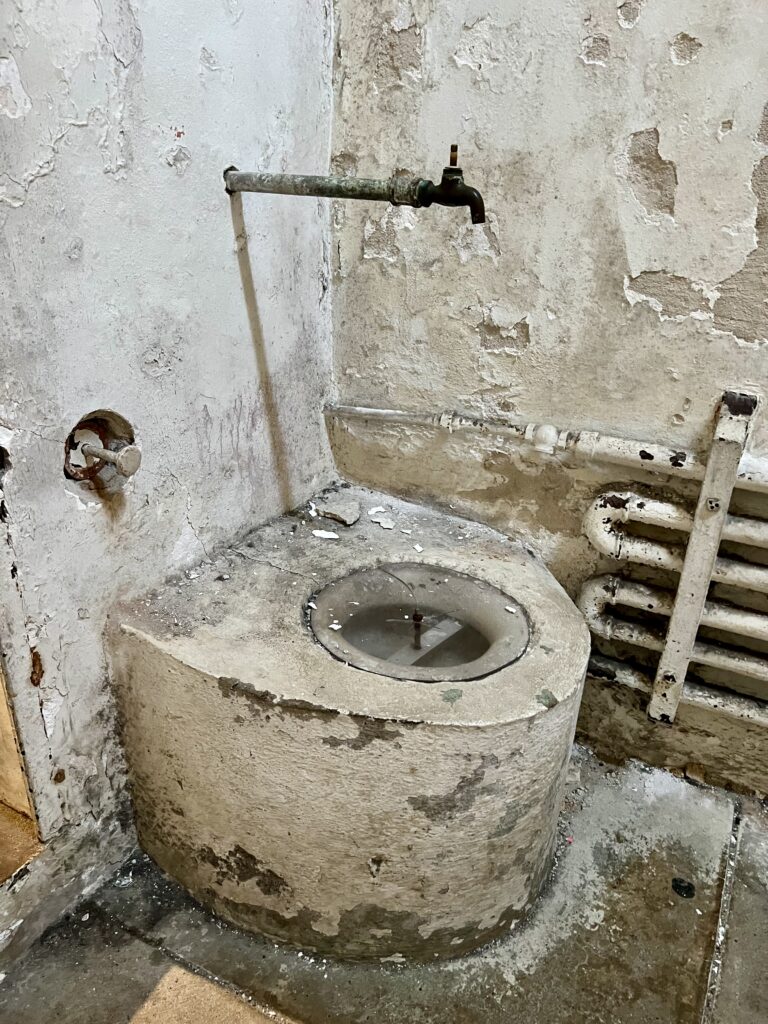
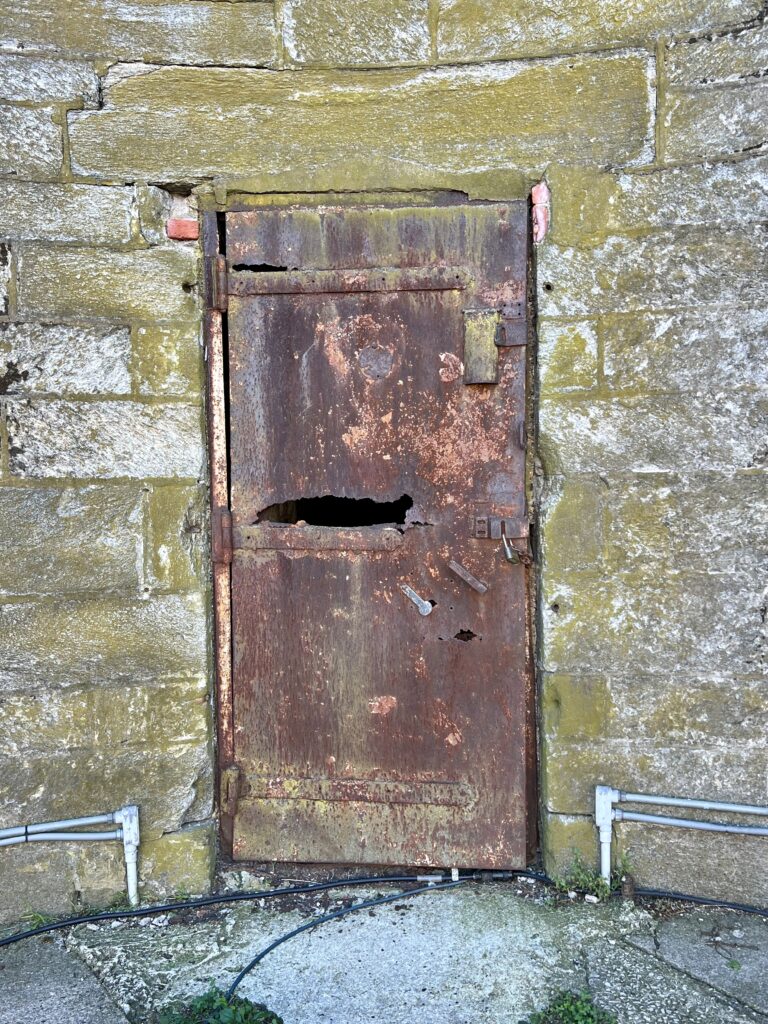
Searchlight Series: ESP partners with criminal justice experts to present lectures on crime, justice, and the American prison system. Check the website under “events” to see what’s on.
I hope you’ve enjoyed my guide to visiting Eastern State Penitentiary. You may enjoy these other Philadelphia travel guides:
- 2 Days in Philadelphia Itinerary
- Top Attractions in Philadelphia
- Guide to Independence National Historical Park
- Guide to the Philadelphia Museum of Art
- Guide to Philadelphia’s Rodin Museum
- Guide to The Barnes Foundation
- Guide to the Mütter Museum
- Guide to the Betsy Ross House
If you need a guide to Eastern State Penitentiary, pin it for later.

